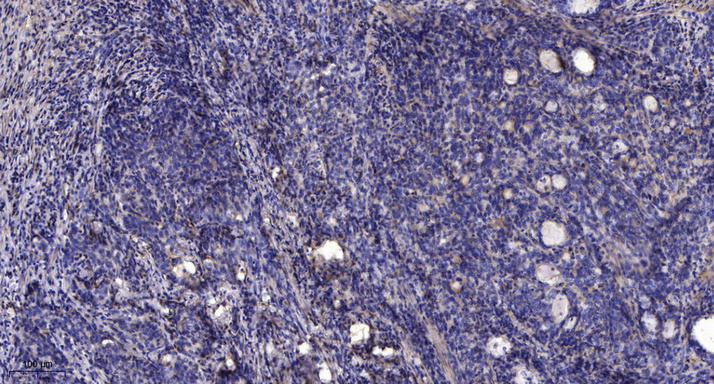KCNH3 Polyclonal Antibody
- Catalog No.:YT2457
- Applications:WB;IHC
- Reactivity:Human;Mouse;Rat
- Target:
- KCNH3
- Gene Name:
- KCNH3
- Protein Name:
- Potassium voltage-gated channel subfamily H member 3
- Human Gene Id:
- 23416
- Human Swiss Prot No:
- Q9ULD8
- Mouse Swiss Prot No:
- Q9WVJ0
- Rat Gene Id:
- 27150
- Rat Swiss Prot No:
- O89047
- Immunogen:
- Synthesized peptide derived from KCNH3 . at AA range: 470-550
- Specificity:
- KCNH3 Polyclonal Antibody detects endogenous levels of KCNH3 protein.
- Formulation:
- Liquid in PBS containing 50% glycerol, 0.5% BSA and 0.02% sodium azide.
- Source:
- Polyclonal, Rabbit,IgG
- Dilution:
- WB 1:500-2000;IHC 1:50-300
- Purification:
- The antibody was affinity-purified from rabbit antiserum by affinity-chromatography using epitope-specific immunogen.
- Concentration:
- 1 mg/ml
- Storage Stability:
- -15°C to -25°C/1 year(Do not lower than -25°C)
- Other Name:
- KCNH3;KIAA1282;Potassium voltage-gated channel subfamily H member 3;Brain-specific eag-like channel 1;BEC1;Ether-a-go-go-like potassium channel 2;ELK channel 2;ELK2;Voltage-gated potassium channel subunit Kv12.2
- Observed Band(KD):
- 120kD
- Background:
- The protein encoded by this gene is a voltage-gated potassium channel alpha subunit predominantly expressed in the forebrain. Studies in mice have found that cognitive function increases when this gene is knocked out. In humans, the encoded protein has been shown to be capable of binding glycoprotein 120 of the human immunodeficiency virus type 1 (HIV-1) envelope. Two transcript variants encoding different isoforms have been found for this gene. [provided by RefSeq, Sep 2015],
- Function:
- domain:The segment S4 is probably the voltage-sensor and is characterized by a series of positively charged amino acids at every third position.,function:Pore-forming (alpha) subunit of voltage-gated potassium channel. Elicits an outward current with fast inactivation. Channel properties may be modulated by cAMP and subunit assembly.,similarity:Belongs to the potassium channel family. H (Eag) subfamily.,similarity:Contains 1 cyclic nucleotide-binding domain.,similarity:Contains 1 PAC (PAS-associated C-terminal) domain.,similarity:Contains 1 PAS (PER-ARNT-SIM) domain.,subunit:The potassium channel is probably composed of a homo- or heterotetrameric complex of pore-forming alpha subunits that can associate with modulating beta subunits.,tissue specificity:Detected only in brain, in particular in the telencephalon. Detected in the cerebral cortex, occipital pole, frontal and temporal lobe,
- Subcellular Location:
- Membrane; Multi-pass membrane protein.
- Expression:
- Detected only in brain, in particular in the telencephalon. Detected in the cerebral cortex, occipital pole, frontal and temporal lobe, putamen, amygdala, hippocampus and caudate nucleus.
- June 19-2018
- WESTERN IMMUNOBLOTTING PROTOCOL
- June 19-2018
- IMMUNOHISTOCHEMISTRY-PARAFFIN PROTOCOL
- June 19-2018
- IMMUNOFLUORESCENCE PROTOCOL
- September 08-2020
- FLOW-CYTOMEYRT-PROTOCOL
- May 20-2022
- Cell-Based ELISA│解您多样本WB检测之困扰
- July 13-2018
- CELL-BASED-ELISA-PROTOCOL-FOR-ACETYL-PROTEIN
- July 13-2018
- CELL-BASED-ELISA-PROTOCOL-FOR-PHOSPHO-PROTEIN
- July 13-2018
- Antibody-FAQs
- Products Images

- Immunohistochemical analysis of paraffin-embedded human Gastric adenocarcinoma. 1, Antibody was diluted at 1:200(4° overnight). 2, Tris-EDTA,pH9.0 was used for antigen retrieval. 3,Secondary antibody was diluted at 1:200(room temperature, 45min).



